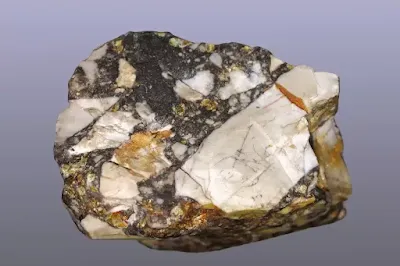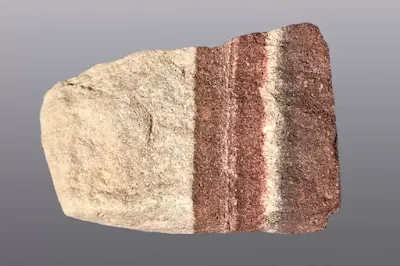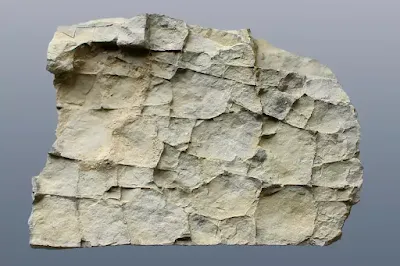Clastic Sedimentary Rocks: Examples with Photos
Clastic sedimentary rocks are rocks that are formed from fragments of pre-existing rocks, minerals, or organic remains that have been transported by wind, water, or ice, deposited in layers, and then cemented together. These fragments, called clasts, can range in size from clay-sized particles to boulders. The size, shape, and composition of the clasts, as well as the type of cement that binds them together, all influence the properties of the resulting clastic sedimentary rock.
The term "clastic" refers to the origin of the rock from broken fragments of other rocks, rather than from the accumulation of organic matter or chemical precipitation, which are the processes that form other types of sedimentary rocks like organic or chemical sedimentary rocks.
Clastic sedimentary rocks vary in grain size, ranging from large gravel-sized particles to very fine clay-sized particles. The size, shape, and sorting of the clasts within the rock can provide valuable information about the environment and the processes involved in their formation.
These rocks are abundant in Earth's crust and are found in a wide range of depositional environments, including rivers, beaches, deserts, lakes, deltas, and deep marine basins. Examples of clastic sedimentary rocks include conglomerate, sandstone, siltstone, and shale.
 |
| Clastic Sedimentary Rocks |
Classification of Clastic Sedimentary Rocks
The classification of clastic sedimentary rocks is based on their origin and composition
Siliciclastic
Siliciclastic rocks are clastic sedimentary rocks, meaning they are formed from fragments of pre-existing rocks. Siliciclastic rocks are most commonly composed of silicate minerals, such as quartz, feldspar, and mica. They can also contain other minerals, such as clay minerals, iron oxides, and calcite. The size, shape, and composition of the clasts in a siliciclastic rock determine its texture and porosity.
Siliciclastic rocks are found in a variety of environments, including riverbeds, beaches, deserts, and deep-sea basins. They are an important source of information about the Earth's history, climate, and geology. Siliciclastic rocks Examples include sandstone, shale, and conglomerate.
Volcaniclastic
These are also clastic sedimentary rocks, but their fragments originate from volcanic eruptions. Volcaniclastic rock composed of volcanic fragments that have been transported some distance from their origin.
These materials are typically deposited during volcanic eruptions and subsequent volcanic activities. Over time, as these materials accumulate and undergo compaction and cementation, they form solid rocks. Volcaniclastic rocks can vary widely in composition, texture, and characteristics depending on factors such as the type of volcanic eruption, the distance from the volcanic source, and the depositional environment.
Volcanic ash, cinders, and breccia (made from volcanic rock fragments) are all considered volcaniclastic rocks.
Primary Volcaniclastic Deposits
Pyroclastic rock and tephra: These form directly from volcanic eruptions. They can include:
- Pyroclastic Rock: Formed from the accumulation and lithification of volcanic ash and other fragments ejected from a volcano during an eruption.
- Tephra: Loose, unconsolidated pyroclastic material that falls to the ground around the volcano. Tephra comes in all sizes, from fine ash to large volcanic bombs.
Secondary Volcaniclastic Deposits
Autoclastic: Autoclastic rocks form from the breaking of volcanic rock within a conduit or vent during an eruption. This breaking can occur due to the expansion of gases, magma-water interactions, or other volcanic processes. Autoclastic rocks often have angular fragments and may include breccias formed from the reworked volcanic material.
Alloclastic: Alloclastic rocks form from the erosion, transportation, and deposition of volcanic rock outside the immediate volcanic conduit. This can include material that has been transported by rivers, glaciers, or other geological processes away from the volcanic source. Alloclastic rocks can include volcaniclastic sedimentary deposits found in various environments.
Volcaniclastic rocks by grain size
Volcaniclastic rocks can be further classified based on the size of the clasts, similar to siliciclastic rocks:
- Volcanic Breccia: Coarse-grained, with clasts larger than 2 millimeters (pea-sized)
- Volcanic Sandstone: Medium-grained, with sand-sized clasts (0.0625 to 2 millimeters)
- Volcanic Mudstone: Fine-grained, with clasts smaller than 0.0625 millimeters
- Tuff: A consolidated rock formed from fine-grained volcanic ash.
Bioclastic
Bioclastic refers to sedimentary rocks or sediment composed primarily of broken fragments or remains of biological organisms. These organisms can include shells, coral fragments, skeletal remains of marine organisms like mollusks and foraminifera, as well as fragments of plants and algae. When organisms die, their hard parts can accumulate on the seafloor or other depositional environments. Over time, these fragments can become compacted and cemented together to form bioclastic rocks.
 |
| Bioclastic Sedimentary Rocks examples: Coquina, Chalk |
There are various types of bioclastic rocks, depending on the dominant type of organisms present and the depositional environment. Some common examples include:
- Coquina: A sedimentary rock primarily composed of loosely cemented shell fragments, often found in beach or shallow marine environments.
- Chalk: Chalk is a soft, white, fine-grained limestone composed mainly of the microscopic calcium carbonate shells of foraminifera and coccolithophores. It commonly forms in deep marine environments.
Terrigenous Sedimentary Rocks
Terrigenous sedimentary rocks are a specific type of clastic sedimentary rock.
Terrigenous comes from the word "terra" meaning land. Therefore, terrigenous sedimentary rocks are clastic rocks formed from the fragments of pre-existing rocks and minerals that originated on land.
Therefore, all terrigenous sedimentary rocks are clastic sedimentary rocks because they are formed from clasts. However, not all clastic sedimentary rocks are terrigenous. Examples of non-terrigenous clastic rocks: Bioclastic rocks, Volcaniclastic rocks
Examples of Clastic sedimentary Rocks
Here are some of the most common examples of clastic sedimentary rocks:
Conglomerate
Conglomerate is a coarse-grained clastic sedimentary rock composed of rounded or angular clasts larger than 2 millimeters in diameter. The clasts in conglomerate can be made of a variety of rock types, including quartz, granite, and basalt. Conglomerate is a strong and durable rock that is sometimes used as a building material. Conglomerates typically form in high-energy environments such as river beds, alluvial fans, or deltas.
 |
| conglomerate rock |
Breccia
Breccia is a coarse-grained clastic sedimentary rock composed of angular clasts larger than 2 millimeters in diameter. Breccia is similar to conglomerate, but the clasts in breccia are angular rather than rounded. Breccia is less common than conglomerate, but it is found in many parts of the world. Breccia is sometimes used as a building material, but it is more commonly used as a source of aggregate for road construction.
Breccias can have a more chaotic appearance due to the angular clasts. The clasts themselves can be a variety of rock types depending on the source rock.
Breccias often form near the source of the rock fragments, such as in fault zones or at the base of steep cliffs where rockfalls occur.
 |
| Breccia rock |
Sandstone
Sandstone is a clastic sedimentary rock composed mainly of sand-sized (0.0625 to 2 mm) mineral grains, most commonly quartz. These sand grains can be rounded or angular, depending on the distance they have been transported. Sandstone is a very common building material and is also used in the production of glass, sandpaper, and other industrial products. Sandstones can form in a variety of environments including beaches, deserts, riverbeds, and shallow marine settings.
Sandstone types by Mineral Composition:
- Quartz arenite: The most common type of sandstone, composed of more than 90% quartz grains. It's very mature and durable due to the chemical resistance of quartz.
- Arkose: Contains significant amounts of feldspar (greater than 25%) along with quartz.
- Lithic arenite: Contains a substantial amount of rock fragments (more than 25%) besides quartz.
- Wacke: Sandstones with a higher percentage of matrix material (clay or mud) filling the spaces between the clasts (more than 15%).
- Graywacke: A type of lithic wacke containing abundant unstable rock and mineral fragments.
 |
| Bedded color sandstone |
Siltstone
Siltstone is a clastic sedimentary rock composed mainly of silt-sized particles (0.0039 to 0.0625 mm). Siltstone is less common than shale or sandstone, but it is found in many parts of the world. Siltstone is sometimes used as a building material, but it is more commonly used as a source of aggregate for road construction. Siltstones are typically deposited in low-energy environments such as lakes, floodplains, or estuaries.
 |
| Siltstone |
Shale
Shale is a fine-grained clastic sedimentary rock composed of clay minerals and silt-sized particles (0.0039 to 0.0625 mm). Shale is often fissile, meaning it can be split into thin sheets. Shale is a common source of clay, which is used in the production of bricks, ceramics, and other products. Shales are the most abundant type of clastic sedimentary rock and often form in quiet water environments such as deep lakes, marine basins, or offshore mud flats.
 |
| shale |
Mudstone
A mixture of clay and silt particles. Mudstone is similar to shale but lacks the fissility characteristic. It is composed of fine-grained clay (smaller than 0.002 mm (2 micrometers)), and silt particles and often forms in similar depositional environments as shale, such as quiet marine or lacustrine settings. It's similar to shale but lacks the fissility, meaning it breaks irregularly instead of splitting into thin layers.
These clastic sedimentary rocks provide valuable information about past environments, sediment transport processes, and the history of sedimentation in different regions. They are essential for reconstructing Earth's geological history and understanding surface processes.
 |
| Mudstone, with Mudcracks |
Conclusion
Clastic sedimentary rocks encompass a diverse range of lithologies, reflecting the dynamic processes of weathering, erosion, transport, and deposition that shape Earth's surface. By examining examples of conglomerate, breccia, sandstone, shale, and mudstone, we gain valuable insights into past environments, sedimentary processes, and the geological history of our planet. These rocks, accompanied by detailed photos, serve as valuable tools for understanding Earth's complex geological processes and the evolution of landscapes over time.


%20(1).webp)





